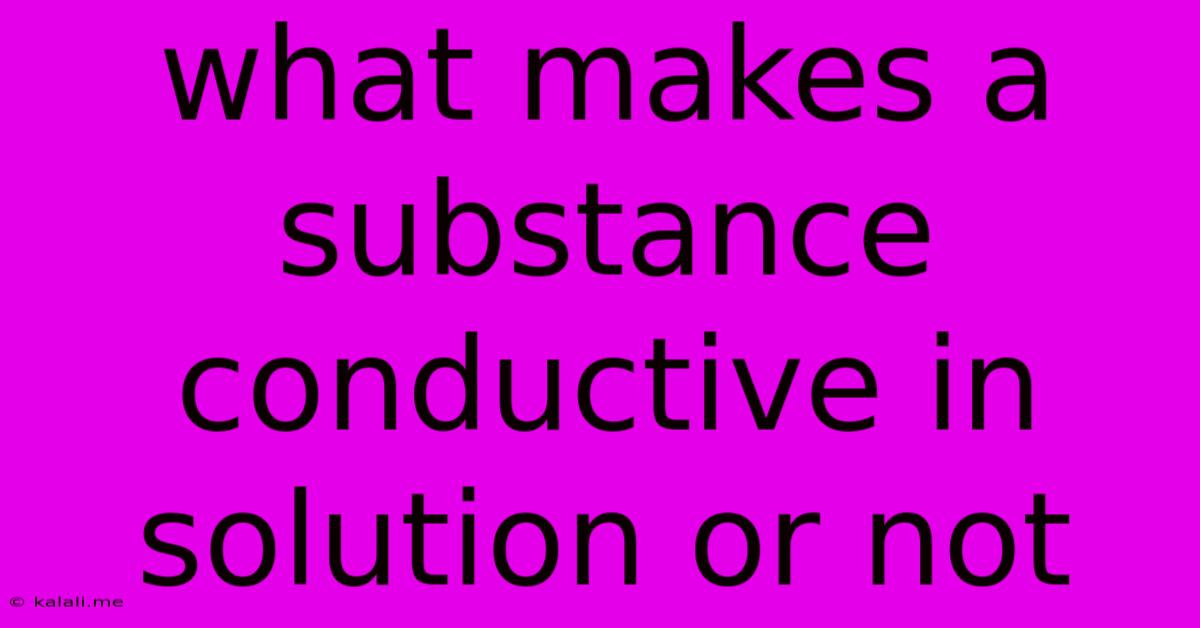What Makes A Substance Conductive In Solution Or Not
Kalali
May 24, 2025 · 3 min read

Table of Contents
What Makes a Substance Conductive in Solution? Understanding Electrolytes and Non-Electrolytes
The ability of a substance to conduct electricity when dissolved in a solution hinges on its capacity to produce ions. This article will delve into the factors that determine whether a substance will readily form ions and thus become an electrolyte, capable of conducting electricity, or remain a non-electrolyte, unable to facilitate electrical current flow. Understanding this concept is crucial in various fields, from chemistry and physics to engineering and biology.
The Role of Ions in Electrical Conductivity
Electrical conductivity in solutions relies on the presence of charged particles, known as ions. These ions, carrying either a positive (cations) or negative (anions) charge, are capable of moving freely and carrying an electrical current when an electric field is applied. The more ions present and the greater their mobility, the higher the solution's conductivity.
Electrolytes: The Conductive Solutions
Substances that, when dissolved in water or another solvent, produce ions and thus conduct electricity are termed electrolytes. Their ability to conduct electricity stems from the dissociation or ionization process. There are two main types of electrolytes:
-
Strong Electrolytes: These substances completely dissociate into ions when dissolved, resulting in a high concentration of free ions and therefore high conductivity. Examples include strong acids (like hydrochloric acid, HCl), strong bases (like sodium hydroxide, NaOH), and most salts (like sodium chloride, NaCl).
-
Weak Electrolytes: These substances only partially dissociate into ions in solution. A significant portion remains as neutral molecules, leading to lower conductivity compared to strong electrolytes. Examples include weak acids (like acetic acid, CH₃COOH), weak bases (like ammonia, NH₃), and some slightly soluble salts.
Non-Electrolytes: The Insulators
Non-electrolytes, conversely, do not produce ions when dissolved. They exist as neutral molecules in solution and cannot conduct electricity. Examples include many organic compounds such as sugars (glucose, sucrose), alcohols (ethanol, methanol), and many covalent compounds. These substances lack the charged species needed to carry an electrical current.
Factors Affecting Conductivity
Several factors influence the conductivity of a solution:
-
Nature of the Solute: The inherent properties of the solute determine its ability to form ions. Ionic compounds generally dissociate readily, while covalent compounds often do not.
-
Solvent Properties: The solvent's polarity and ability to solvate ions significantly impact conductivity. Polar solvents, such as water, are better at dissolving ionic compounds and facilitating ion mobility.
-
Concentration: A higher concentration of ions leads to increased conductivity, as more charge carriers are available.
-
Temperature: Increased temperature generally enhances conductivity by increasing ion mobility. Higher kinetic energy allows ions to move more freely.
Identifying Electrolytes and Non-Electrolytes
Experimentally, the conductivity of a solution can be determined using a simple conductivity meter. A solution's ability to allow the flow of electric current provides a direct measure of its electrolyte nature.
Conclusion
The electrical conductivity of a solution is directly linked to the presence and mobility of ions. Electrolytes, which readily dissociate into ions, conduct electricity, while non-electrolytes, lacking these charged particles, do not. Understanding the factors influencing ion formation and mobility is crucial for predicting and controlling the conductivity of various solutions. This knowledge has broad implications in numerous scientific and engineering applications.
Latest Posts
Latest Posts
-
Smoke Detector Beeping With New Battery
May 24, 2025
-
Dot 3 Vs Dot 4 Brake Fluid
May 24, 2025
-
How Much To Tip At Barbershop
May 24, 2025
-
Can You Bring Protein Powder On A Plane
May 24, 2025
-
American Airlines Suspends Flights To Israel Until 2025
May 24, 2025
Related Post
Thank you for visiting our website which covers about What Makes A Substance Conductive In Solution Or Not . We hope the information provided has been useful to you. Feel free to contact us if you have any questions or need further assistance. See you next time and don't miss to bookmark.